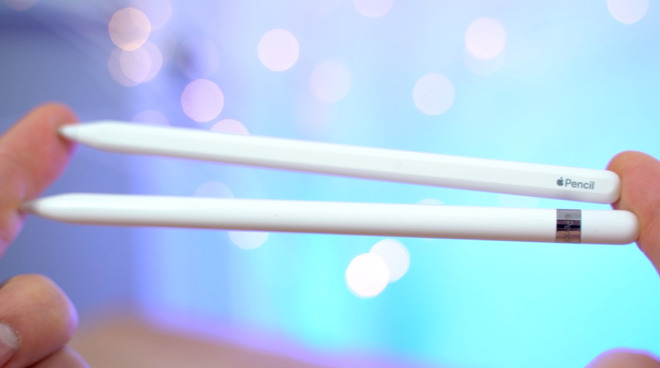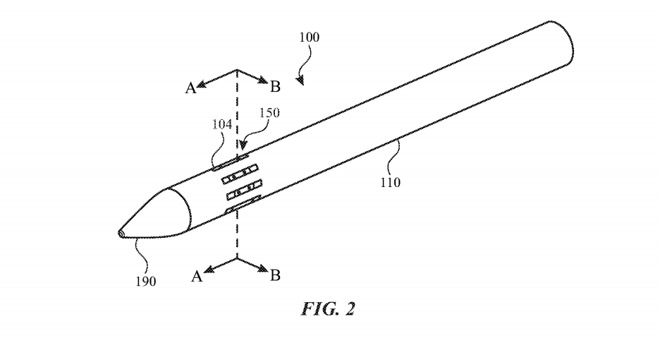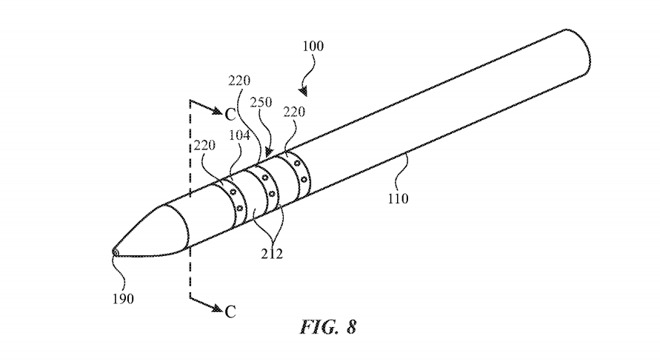Apple Pencil haptics could give feedback to users without shaking the stylus
A future Apple Pencil could give more information to the user wielding it using haptic feedback, with Apple examining ways to create a shear force to physically inform users of touch events, via a small sensation at the fingertips.

The Apple Pencil and other similar stylus tools typically have to rely on the host device to provide feedback to the user, such as visual or audio stimulus. While haptic feedback is useful in other areas, like with game controllers or iPhone vibration alerts without a ringtone, such a system is typically not present in a stylus.
The problem is that adding a motor and an offset weight designed to shake a device or accessory isn't a great thing to add to a drawing tool, where the user demands absolute control over its position. Typical haptic systems would shake the stylus, which could shift it and make a straight line that is being drawn into a wobbly version that has to be redone.
If haptic feedback is to be included in a stylus, it has to be done so without causing it to shake.
In the patent application titled "Stylus with shear force feedback," Apple proposes a system where there is a sensation of a shear force that is applied to elements close to the user's fingertips. The use of shear forces could be performed in such a way that could apply to different areas of the hand, and in different directions.
By applying forces in different directions simultaneously, Apple believes they negate each other, effectively keeping the stylus where it is, while still exhibiting some form of haptic communication to the user.

An example of the slitted stylus from the patent application
To accomplish this, Apple proposes the use of various additions at the point of the stylus where the user's fingers make contact while drawing. This would typically be close to the nib end of the tool itself.
In one incarnation, there are a series of vertical slits that contain a material connected to a motor, which rubs against the user's fingers to create the sensation. In a second version, rings around the stylus have little bumps to enhance the feeling when the internal motor moves.
For both proposals, there are sufficient fixed elements in-between the slits and the rings that remain stationary, giving users a place to firmly grip the stylus and to not move. As the motions of the elements could be performed in different directions at the same time, this would satisfy the requirement of providing haptic feedback without affecting the overall motion of the stylus itself.
Apple envisions the feedback could be used to provide notification of areas of a display the stylus can interact with, like a button, or boundaries of an input box, or to signify the occurrence of a function.

The ring-based version of the stylus feedback concept
The filing lists David H. Bloom, Benjamin G. Jackson, and Steven J. Taylor as its inventors.
Bloom has been linkedto patents and applications including an "Off-Center Pivoting Earpiece," methods of interaction with an "Intensity-Sensitive Input Region," and what appear to be gloves designed for AR and VR interactions. Jackson has been linked to a "Dynamically configurable input structure with tactile overlay" patent, as well as other filings involving haptic feedback, rotatable input mechanisms with adjustable outputs, and even a "Haptic mouse."
Apple files numerous patent applications on a weekly basis, but while the existence of a filing indicates areas of interest for Apple's research and development efforts, they do not guarantee the concept will appear in a future product or service.
This is not Apple's first crack at Apple Pencil haptic feedback, as one filing in December 2019 suggested how Apple could use a movable tip and force feedback to give the sensation of drawing on different surfaces.
Other related stylus patent filings cover the addition of full touch-sensitive controls, the use of swappable nibs that provide different functions, a light-up tip to show a selected color, and a system for using an Apple Pencil on any flat surface or in the air near to a host device.

The Apple Pencil and other similar stylus tools typically have to rely on the host device to provide feedback to the user, such as visual or audio stimulus. While haptic feedback is useful in other areas, like with game controllers or iPhone vibration alerts without a ringtone, such a system is typically not present in a stylus.
The problem is that adding a motor and an offset weight designed to shake a device or accessory isn't a great thing to add to a drawing tool, where the user demands absolute control over its position. Typical haptic systems would shake the stylus, which could shift it and make a straight line that is being drawn into a wobbly version that has to be redone.
If haptic feedback is to be included in a stylus, it has to be done so without causing it to shake.
In the patent application titled "Stylus with shear force feedback," Apple proposes a system where there is a sensation of a shear force that is applied to elements close to the user's fingertips. The use of shear forces could be performed in such a way that could apply to different areas of the hand, and in different directions.
By applying forces in different directions simultaneously, Apple believes they negate each other, effectively keeping the stylus where it is, while still exhibiting some form of haptic communication to the user.

An example of the slitted stylus from the patent application
To accomplish this, Apple proposes the use of various additions at the point of the stylus where the user's fingers make contact while drawing. This would typically be close to the nib end of the tool itself.
In one incarnation, there are a series of vertical slits that contain a material connected to a motor, which rubs against the user's fingers to create the sensation. In a second version, rings around the stylus have little bumps to enhance the feeling when the internal motor moves.
For both proposals, there are sufficient fixed elements in-between the slits and the rings that remain stationary, giving users a place to firmly grip the stylus and to not move. As the motions of the elements could be performed in different directions at the same time, this would satisfy the requirement of providing haptic feedback without affecting the overall motion of the stylus itself.
Apple envisions the feedback could be used to provide notification of areas of a display the stylus can interact with, like a button, or boundaries of an input box, or to signify the occurrence of a function.

The ring-based version of the stylus feedback concept
The filing lists David H. Bloom, Benjamin G. Jackson, and Steven J. Taylor as its inventors.
Bloom has been linkedto patents and applications including an "Off-Center Pivoting Earpiece," methods of interaction with an "Intensity-Sensitive Input Region," and what appear to be gloves designed for AR and VR interactions. Jackson has been linked to a "Dynamically configurable input structure with tactile overlay" patent, as well as other filings involving haptic feedback, rotatable input mechanisms with adjustable outputs, and even a "Haptic mouse."
Apple files numerous patent applications on a weekly basis, but while the existence of a filing indicates areas of interest for Apple's research and development efforts, they do not guarantee the concept will appear in a future product or service.
This is not Apple's first crack at Apple Pencil haptic feedback, as one filing in December 2019 suggested how Apple could use a movable tip and force feedback to give the sensation of drawing on different surfaces.
Other related stylus patent filings cover the addition of full touch-sensitive controls, the use of swappable nibs that provide different functions, a light-up tip to show a selected color, and a system for using an Apple Pencil on any flat surface or in the air near to a host device.

Comments
For haptic feedback to simulate the friction of a pencil or pen writing on surface, I was thinking Apple would go with a super small Taptic Engine, a linear oscillator not a rotational one, that is sized for the tip in the Pencil. The mass difference between the tip and the rest of the Pencil has to be huge, like MB trackpad huge to laptop mass huge, so that most of the vibration is generated at the tip. Was wondering if that would simulate a feeling of friction. Perhaps not.